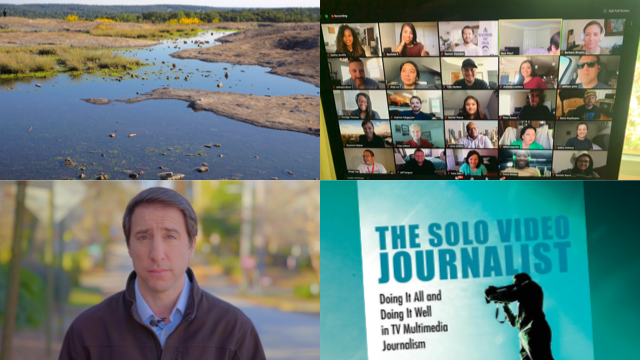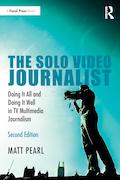Podcast: Play in new window | Download
Subscribe: RSS
There’s a line I sometimes recite when I feel I’ve reached a professional roadblock.
It’s a punchline from an eighth-season episode of Seinfeld, where George Costanza is trying to spin his meager life triumphs amid countless failures into a grand success story.
“You know,” he says, “if you take everything I’ve accomplished in my entire life and condense it down into one day … it looks decent!”
When I watched two decades ago, I laughed with everyone else. We’re supposed to laugh at George. The line is meant to mock him.
But these days, it’s become somewhat of a mantra, a reminder of the power of the big picture. When I feel stagnant in my career, I reflect on what I’ve accomplished and discover a lengthier list than I realized. When I’m shooting a story and don’t feel like I’m capturing what I need, I aim to stay focused and remember I might feel differently by day’s end. In the moment, I often dwell on mistakes and failures. In the aggregate, I see a career that, condensed into a few paragraphs, looks decent.
And in 2020, when limitations and frustrations loomed over every day, I leaned on George’s line – or, at least, the optimism within it – to push through.
No matter your role, your life was disrupted sometime this past March. The COVID-19 pandemic forced newsrooms to close and news employees to adjust. Most of us still work from home. Many of us can’t shoot video indoors without our bosses’ permission. We can’t travel like we did. We can’t immerse ourselves the same way in our stories. And, for those like me with young children at home, we face challenges of work-life balance that often seem insurmountable.
I spent much of 2020 feeling like I wasn’t fulfilling my potential. I sat out major stories. I couldn’t approach others with the same ambition because I realized the toll it would take at home. For a long time, with a months-old daughter sleeping in our room (and often not sleeping), a successful day meant summoning enough energy to get through both my work shift and the additional hours overseeing a toddler and infant. I could barely focus while writing scripts. I scraped for extra minutes to plan future stories. I rarely felt I had enough time.
Even this morning, I woke up extra-early to write this essay and was eight paragraphs in when I heard, well before my two-year-old daughter’s wake-up time, a holler from her room:
“Where are you, Dada?”
“Where are you, Dada?”
“WHERE ARE YOU, DADA?”
“WHEEEEERE AAAAARE YOUUUU, DAAADAAAA?”
I laugh at and live for these moments, and I’ve never taken for granted the beauty in the bonus time with my family. But at work, I couldn’t reach my usual standards, and it left me frustrated.
Then I stepped back and realized what those frustrations had borne. And I became immensely proud.
In 2020 I continued to produce meaningful stories, even receiving the opportunity to work with the special projects team at my station. I MMJ’d a documentary, The Ripple, about the pandemic’s overlooked effects on underserved communities. (I shot most of it during a glorious two-week period when my parents came down to visit and babysit.) I used the lack of significant shooting opportunities to improve my post-production and get stronger at Adobe After Effects. I learned Adobe Premiere and now use it as my primary editing software – a longtime goal I finally accomplished.
Outside the newsroom came two of my proudest achievements. When so many storytelling workshops and conferences were getting postponed or cancelled, I reached out to the NPPA to see if I could plan a virtual video storytelling workshop. Two months later, we gathered more than 200 journalists and an all-star speaking line-up over Zoom for an inspiring weekend that will remain a highlight of my career. And in the early stages of the pandemic, not to mention the earliest months of my younger daughter’s life, I copy edited the 2nd edition of my book, The Solo Video Journalist, a how-to guide for those of us who produce stories as one-person crews. My publisher released it over the summer.
If you condense my year into two paragraphs, it looks decent.
I know I’m not alone. Maybe we all didn’t write books or plan workshops, but I think most of us can look back at 2020 and find successes amidst the struggle. It’s an important perspective for 2021, when we may perhaps return to something approaching our pre-pandemic lives. Burnout will remain a risk. Stress will remain a constant. We will need to navigate our dreams, expectations, and assignments with steady minds. That starts with thinking big and always keeping sight of our larger goals. It means absorbing our circumstances and continuing to push.
As I write this, I’m on a break, finally taking two weeks to relax after nine months ramming against the pandemic wall. I’ve given myself permission to divorce myself from work for a stretch – this essay notwithstanding – and recharge my professional batteries. But by the time you read this, I’ll be back in the thick of it: setting goals, thinking big, and trying to remind myself of that unexpected bit of wisdom from a character named Costanza.
The Solo Video Journalist is available for purchase. You can find it on Amazon, Barnes & Noble, and the publisher’s web site.
Matt Pearl is the author of the Telling the Story blog and podcast. Feel free to comment below or e-mail Matt at matt@tellingthestoryblog.com. You can also follow Matt on Facebook and Twitter.

